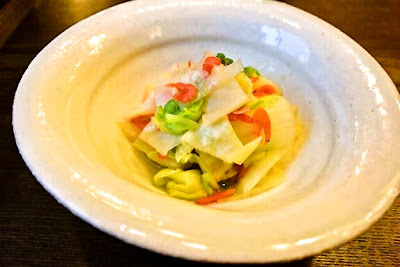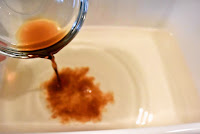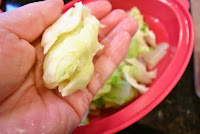The soft green color of cabbage and napa cabbage makes a nice contrast with the pretty pink of sakura ebi. Both vegetables are microwaved for quick preparation, which also minimizes loss of vitamins into water when boiling them. This side dish has a gentle sweet aftertaste with a hint of clear saltiness, and goes well with dishes that have strong flavor or are prepared with oil.
1/2 of recipe: 19 calories; 1.7 g protein; 0.4 g fat; 3.4 g carbohydrate; 2.3 g net carbs; 119 mg sodium; 9 mg cholesterol; 1.1 g fiber; 183 mg potassium
<Ingredients>
Approx. 50 g hakusai napa cabbage (2 leaves, 54 g in photo)
2.5 g sakura ebi dried shrimp
For ohitashi light broth marinade
150 cc dashi
3/4 tsp usukuchi pale soy sauce
<Directions>
1.
Cut cabbage and hakusai napa cabbage into 3-4 cm squares.
2.
In a microwaveable container, place cabbage, cover, and microwave for 1 minute.
At the same time, microwave sakura ebi without cover until toasty, removing after 20-30 seconds (when sakura ebi become toasty).
3.
Put hakusai on top of cabbage, cover, and microwave for another 1 minute or so until green part of both vegetables become brighter and white part becomes somewhat translucent.
(Transfer to zaru strainer, colander or tray to cool, if in a hurry).
4.
Meanwhile, add usukuchi pale soy sauce to dashi, and mix.
Cool the mixture to at least room temperature, if necessary.
5.
When cabbage and hakusai are cool (at least to room temperature), squeeze out excess moisture, and put in dashi + soy sauce mixture.
Put sakura ebi, and mix.
Let soak for 30+ minutes.
<Notes>
- Vegetables continue to absorb flavor (and sodium) as they marinate. If you plan to eat hours later, remove vegetables and sakura ebi from ohitashi marinade after 2-3 hours (and pour over marinade when serving, if desired), or reduce the amount of usukuchi soy sauce somewhat (to 1/2 teaspoon or so).
- Cooling both ohitashi marinade and vegetables is to prevent further cooking of the vegetables.
- If usukuchi pale soy sauce is not available, regular soy sauce works fine. To mimic the same effect (paler finished color and clearer saltiness), reduce the amount of soy sauce and add a tiny pinch of salt (or shiokoji salted rice malt for lower sodium) -- 1/2 tsp of regular reduced-sodium soy sauce and 1/8 tsp shiokoji, for example.
- With both cabbage and hakusai, inner leaves are much sweeter, which becomes more noticeable when cooked. The above is made with the inner leaves of cabbage and outer leaves of hakusai for color. The photo at right is made with outer (greener) leaves of cabbage and inner leaves of hakusai.
- Using only one (either cabbage or hakusai) works great, too.
- The above nutrition figures, other than sodium, are based on an assumption that 50% of ohitashi marinade is consumed with vegetables. The sodium figure is calculated based on measurement of leftover ohitashi marinade after vegetables are consumed.















No comments:
Post a Comment